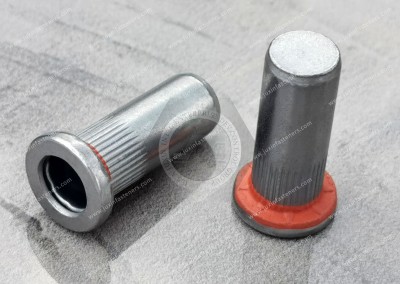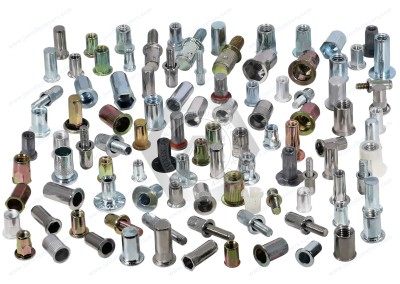Call Us
+86 136 6007 9809
Call Us
+86 136 6007 9809
Aug. 19, 2023
Blind rivet nuts are widely used to assemble electromechanical and light industrial products, such as automobiles, aviation, instruments, furniture, and decorations. They are suitable for fastening various thicknesses of sheet metal and pipes (0.5 to 6mm). They provide strong riveting, high efficiency, and easy use. Existing Blind rivet nuts, when fixedly connected to sheet metal parts, often result in metal-to-metal contact between the two materials, leading to poor sealing performance and inability to meet airtightness requirements. Therefore, a sealing structure for blind rivet nuts must ensure a tight connection and good sealing performance. The present utility model provides a sealing structure for blind rivet nuts, addressing the problems in the existing technology described above. As the power source of electric vehicles, the safety of battery packs directly affects the vehicle's overall safety. Battery packs installed under the chassis need to meet at least an IP67 rating for dust and water resistance to ensure the waterproof sealing performance of the battery pack. The sealing structure design of electric vehicle battery packs primarily involves the mechanical sealing design, which needs to consider the following essential parts: the connection interface between the lower and upper boxes, high and low voltage connectors, and the installation interface between exposed devices and the battery box. The sealing surfaces of the upper and lower boxes of the battery pack are large, and the sealing effect significantly impacts the overall sealing performance of the battery pack. Generally, the upper and lower boxes of the battery pack adopt a design with bent flanges and sealing gaskets. At the same time, the bolt holes of the sealing gasket are pressed onto the rivet nuts on the flange of the lower box, and the coupling between the flanges and the sealing gasket is sufficiently tightened through fastening bolts. This ensures the IP67 dust and water resistance rating of the battery box.
Blind rivet nuts solve the problems of complex thread tapping on metal sheets, the tendency for welding nuts to burn through thin pipes, and the vulnerability to thread damage. They enable threaded connections between thin plates and other components. Blind rivet nuts provide high efficiency and low cost for fastening. In the production process of battery enclosures, blind rivet nuts (primarily M5 and M6 with a stepped thickness of 2.5mm and a flat head with a semi-hexagonal through-hole) are used. Blind hole blind rivet nuts are mainly installed on the sealing surfaces of the enclosure frame to achieve mechanical connection with the upper cover, and they are also installed on the bottom plate of the enclosure to connect modules or other components to the enclosure.


Blind rivet Nuts combine the principles of core-pulling rivets and welding nuts. The result is increased reusable thread strength in sheet metal materials. Blind rivet nuts can be used from a single side of the application parts; they are dependent on the thin metal pre-positioning device through the extrusion deformation to achieve excellent thin-wall riveting, sealing riveting, single-sided riveting, and so on. A blind rivet nut is mainly used through the rivet gun to rivet, which is more suitable for square tubes, round tubes, and other places where it is not easy to pressure riveting operation. A blind rivet nut is delicious enough to compensate for the shortcomings of electric welding, such as thin plates and other places that are not easy to weld; the aesthetics are also excellent to improve. Blind rivet nuts are widely used in chassis cabinets, square and round tubes, fans, and zinc steel fences.
The primary materials of blind rivet nuts include stainless steel, aluminum, copper, and steel. Standard materials of blind rivet nuts are 316 stainless steel, 316L stainless steel, 304 stainless steel, carbon steel (08A) aluminum, and copper. A blind rivet nut is a combination of the principle of core extraction rivets and welded nuts so that the sheet metal material thread strength and can be reused; blind rivet nuts can be used from the application of a single side of the part; they are dependent on the pre-positioning of the thin metal device, through the deformation of the cold extrusion to achieve excellent thin-wall riveting, sealing riveting and one-sided riveting, etc. The blind rivet nut is mainly used through the rivet gun for blind riveting, which is more suitable for square tubes, round tubes, and other places where it is not easy to perform a pressure riveting operation. The blind rivet nut is delicious to make up for the shortcomings of electric welding. For example, thin plates and other places that are not easy to weld have also improved the aesthetics!
Contact Us
Tel.:
+86 020 8621 0320
+86 020 3121 6067
Technical Support:
Navigation
SEND INQUIREY